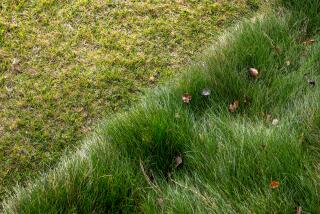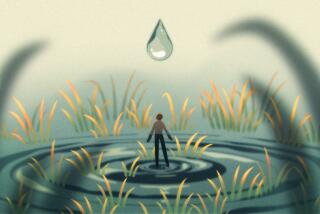YARDS : Turf Battles : How do you keep a yard in the condition that makes it enjoyable? By giving it everything it wants.
- Share via
Keeping a lawn alive and well can be a frustrating experience -- even for a determined yard owner.
It always seems to need something: water, sunshine, mowing, thatching, debugging, fertilizing. Why bother with a lawn? you may ask. Because, despite the attention it needs, it does several things very well--like provide a soft, comfortable area for play or relaxation, and, on the practical side, reduce dust and help prevent soil erosion.
There’s no other plant quite like grass, says turf grass expert Michael Henry, environmental horticulture adviser for Orange, Riverside and Los Angeles counties with the UC Cooperative Extension. “It’s hard to match the color, texture and density of lawns with any other kind of plant material. Aesthetically, lawns also provide a nice contrast to ground cover, shrubs, trees and flower beds in the garden.”
Despite how common lawns are, they are probably the most misunderstood and poorly treated of plants, says Steve Hollister, a California-certified nurseryman and manager of Armstrong Garden Center in Irvine. By keeping grass short and growing it close together, people force it to grow against its nature.
“Most people wouldn’t recognize their lawns if they saw them growing naturally in an unmowed state,” says Hollister. “It’s like growing a rosebush and not letting it get more than six inches high.”
If your more immediate concern is keeping the lawn alive this summer, don’t despair. Armed with the right information and a willingness to give your lawn the attention it wants, you too can have a healthy crop of grass.
Here are some tactics for keeping your lawn at its best:
WATERING
Experts say that most people fail their lawns when it comes to watering. “Typically people water lawns too often with an insufficient amount of water,” says Hollister. When you water once a day for just a few minutes at a time, water doesn’t penetrate the ground more than two to three inches. Such shallow watering prevents grass from developing a deep, healthy root system, which makes it vulnerable on hot summer days. Because they’ve been watering every day, though, many people don’t know that water stress is the problem.
Stress from lack of water is often hard to detect until the lawn begins to yellow, and by that time things are really bad. “When a lawn undergoes drought stress, it doesn’t immediately turn yellow but from a distance will look a dark, dull green, as opposed to vibrant, shiny and healthy,” says Hollister.
“Another indication of stressed grass is if your footprints remain on the grass after walking over it. This means that the lawn’s water pressure is low,” he says.
Each time you water, give your lawn a deep, thorough drink, and you’ll be rewarded with deep-rooted grass strong enough to fight scorching summer days and drying Santa Ana winds.
Although watering requirements vary for different grass types, in general, lawns should be watered one to three times a week, depending on the weather. During periods of rain you may not need to water at all, says Hollister.
You should apply about half an inch of water to the ground each time you water. All sprinkler systems are different, however. To evaluate your system, see how long it takes for half an inch of water to collect in cups or cans set around the lawn. By checking different locations, you also get a better picture of dry and wet spots.
You may find, for instance, that it takes your sprinklers about 15 minutes to deliver half an inch of water. However, unless you have a perfectly level lawn with excellent drainage, you’re likely to get pooling and runoff if you douse a lawn with 15 minutes of water all at once. To ensure absorption, water for three to five minutes at a time at one-hour intervals until you reach the optimum watering time for your lawn.
CHECKING MOISTURE
To see if your lawn has been getting enough water, you can perform one of several tests.
“Stick a screwdriver into the ground,” suggests turf expert Henry. “The screwdriver should easily penetrate four to six inches for warm-season grasses and six to 12 inches for cool-season grasses. If the screwdriver gets stuck indry soil before reaching these depths, the lawn isn’t getting enough water.”
You can also use a moisture meter inserted to the same levels or simply take a mound of soil and try to form a ball with it. If the ball crumbles, the soil isn’t wet enough.
If you’re having trouble getting water into your soil, try a soil wetting agent, which will help water penetrate reluctant lawns. This can be found at nurseries and only needs to be applied a couple times a year.
CORING
You can also get water to penetrate the ground by coring your lawn. This refers to extracting deep, skinny cores of soil with a manual or mechanical sod coring tool that looks like a long, skinny cookie cutter. This coring not only allows water penetration, it also loosens and aerates the soil, which is very good for the lawn.
When coring your grass, it’s also a good time to apply a mulch, which will fall into the holes. This mulch will cool the grass roots and break down, creating a healthier soil. For mulch, use planter mix or lawn seed covers. In general you want 1 1/2 to two cubic feet of mulch for every 100 square feet, says Hollister. Such a concentration will disappear after a couple of waterings.
Experts don’t recommend spiked “aeration” shoes. These shoes don’t aerate the soil, but actually compress it.
MOWING
Many mistakes in lawn care are made in mowing, says Henry. He notes that contrary to popular opinion, grass clippings should be left on the lawn. “Leaving grass clippings on doesn’t harm the grass at all,” he says. The grass decomposes and returns nitrogen to the lawn, and this practice reduces the materials sent to landfills. There are mulching mowers on the market that automatically return grass clippings to the ground.
Many people wait too long between mowings. “You don’t want to cut off more than one-third of the grass at any one mowing because mowing too much can send the grass into shock,” says California-certified nurseryman Gary Matsuoka of Laguna Hills Nursery Inc. in Lake Forest. Many grasses need to be mowed once a week, and some fast-growing types--such as hybrid Bermuda--twice a week during warm weather.
How close to cut your grass depends on the type. In general, most cool season grasses like fescue should be cut no lower than three inches in the summer and a little lower in winter. Bluegrass and rye grass combination lawns should be cut about two inches, hybrid Bermuda much shorter at about three-quarters of an inch, and St. Augustine anywhere from one-half to two inches.
Also make sure that your lawn mower blade is sharp. Dull blades will tear grass edges, which gives a lawn a brown or yellow cast from a distance.
DETHATCHING
Dethatching is another important maintenance task that leads to a healthy lawn, says Matsuoka. Thatch is a harmful buildup of plant material that impedes air and water movement to the soil.
To dethatch, you need to rent a machine that will remove dead plant material from the lawn. Dethatching should be done about once a year, depending on your lawn type. When thatch isn’t taken care of, lawns tend to die out in areas, leaving bare spots.
PESTS
Pests and disease aren’t too much of a problem for mixed lawns that have more than one grass type. If you have a pure lawn, however, there is a chance you could have some trouble.
Most single grasses are vulnerable to certain insect problems such as cut worms, web worms and grubs. Such problems respond to herbicide treatment. There are also biological controls on the market, but they haven’t been thoroughly tested, says Matsuoka.
Take a look at many well-established lawns in Orange County and you’re bound to see grass mixtures. Not only are such mixes more resistant to pests and diseases, if you have a cool season and warm season combination, the lawn can look green all year.
Another way to have green grass all year is to have a warm season grass like hybrid Bermuda and seed annual rye grass every fall. The rye grass will remain green all winter while the Bermuda becomes dormant and yellow.
FERTILIZING
Finally, to be its best, a lawn should be fertilized on a regular basis. What it really needs is nitrogen, because it is constantly regrowing the leaves that have been cut in mowing.
A fertilizer is identified by three numbers, such as 10-6-4, the first being nitrogen content, followed by phosphorus. Although how much fertilizer you use will vary according to your grass type, in general you should fertilize a lawn with about four pounds of nitrogen per 1,000 square feet each year, says Henry. This typically means fertilizing three or four times per year.
All fertilizers, whether organic or not, should be used according to instructions.
Watering Lawns Correctly
Watering roots properly allows roots to grow deep into soil.
After two days surface dries but with deep root system lawn stays nourished.
In one week, soil becomes very dry, leaving roots stressed. Shallow-rooted turf grass wilts.
Source: NK Lawn and Garden Co.






